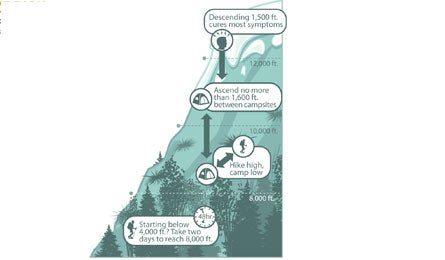The Manual: Stay Healthy at Altitude

'Illustration by Supercorn'
Prepping for a fall peakbagging trip? Don’t let acute mountain sickness (AMS) ruin it. The accompanying headaches, fatigue, loss of appetite, and nausea can dampen any alpine trek, and without treatment can turn into a medical emergency. Here, learn how to take a go-high trip without getting laid low by AMS.
Minimize Risk
“Before going to high elevations, assess the risk profile of your ascent,” says Andrew Luks, M.D., professor of pulmonary medicine at the University of Washington. Here’s how to plan a high-altitude trip.
Start slow Many hikers can ascend with no ill effects, but if you’re prone to AMS (you’ve experienced it before) or have never traveled above 4,000 feet, consider yourself high risk. Schedule rest.
Ascend gradually Above 8,000 feet, climb conservatively, stay hydrated, and be alert for symptoms of AMS. Going big? Gaining up to 14,000 feet per day (from Seattle to Mt. Rainier, for example) can be safe, but expect mild headaches and fatigue, and descend immediately if AMS symptoms worsen.
Sleep low Respiration decreases during sleep, especially above 10,000 feet. That means reduced oxygen intake, which causes restlessness and affects performance. Hike high during the day, but limit sleeping elevation gains to 1,600 feet per night, and sleep as low as possible before summit attempts.
Beware the danger zone AMS risk increases with altitude. At 14,000 feet, just 61 percent of the oxygen at sea level is available.
Plan a route with a fast descent Feeling sick? Dropping just 1,500 feet is usually enough to recover.
Recognize it
Acute Mountain Sickness Low atmospheric pressure at altitude reduces air density and makes it difficult for the vascular system to absorb and circulate oxygen. AMS is your body’s response to the oxygen deficiency. Symptoms Nausea, vomiting, headache, insomnia, fatigue Severity Similar to a hangover; mild symptoms appear within 10 hours. Probability In Summit County, Colorado, one quarter of visitors experience symptoms of AMS above 8,000 feet, and nearly half do at 10,000 feet.
High Altitude Pulmonary Edema (HAPE) Fluid buildup in the lungs Symptoms Dry cough, shortness of breath at rest, severe trouble breathing Severity HAPE is the most common cause of altitude-related deaths. Probability Severe cases are rare, but one in 100 climbers above 14,000 feet experiences symptoms that require treatment.
High Altitude Cerebral Edema (HACE) Fluid-caused cranial pressure Symptoms Mental impairment, confusion, loss of coordination/balance Severity HACE can be fatal; immediate descent is required. Probability Can occur above 10,000 feet, but is rare below 14,000 feet.
Training
The best prep? Spend time hiking above 8,000 feet. But if you live at sea level, build aerobic capacity by exercising at 70 percent of your max heart rate four times a week. Also, maintain your iron level, which helps with oxygen delivery. Take supplements or eat iron-rich foods, like red meat and greens.
Treatment: OTC
Take ibuprofen for headaches and ginger extract or capsules for nausea. Altitude accelerates dehydration, which compounds AMS symptoms; avoid alcohol, reduce caffeine intake, and drink enough water so your urine is pale. Eating carbohydrates may also help combat fatigue. If symptoms don’t improve after two days, descend. If you have severe trouble breathing or are disoriented, descend immediately and seek medical attention.
Treatment: Prescription
Acetazolamide This diuretic—sold under the brand name Diamox—is a go-to drug for AMS prevention and treatment. Diamox causes your kidneys to excrete bicarbonate, which slightly acidifies the blood, causing deeper breathing and increased blood oxygen levels. For prevention, take it a day or two before you hit the trail. If you take it when symptoms strike, expect to wait 24 hours or more before they subside. Acetazolamide does not treat HACE or HAPE, so if AMS symptoms persist or worsen, descend to a lower elevation. Side effects include numbness of the extremities and sun sensitivity. Also, carbonated drinks taste bitter, metallic, or sharp.
Dexamethasone An alternative for hikers who can’t tolerate Diamox, dexamethasone treats symptoms of AMS, HAPE, and HACE. This powerful steroid reduces swelling and fluid buildup, but does not speed acclimatization. It’s also an immunosuppressant, so it’s not safe for long-term use.
Viagra and Cialis Don’t believe the rumors. Both drugs decrease blood pressure in the lungs, but, says Luks, “These medications have no proven role in the prevention or treatment of AMS or HACE.”